Overnight New York Style Bagels
These bagels are chewy, crusty and properly dense New York Style Bagels. The overnight rise creates the perfect texture and flavor – and you’ll have fresh, hot bagels for breakfast or brunch less than an hour after getting out of bed.
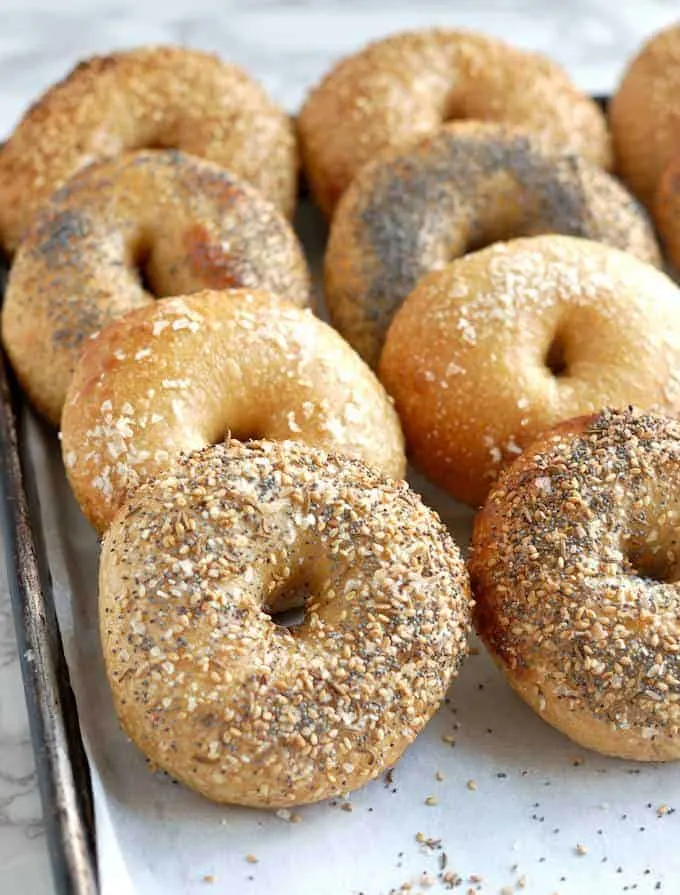
What is a true New York Style Bagel?
I promise you if you follow this recipe correctly you can make a good bagel at home. I mean, there are loads of really bad bagels in the world and life is just too short to eat a bad bagel.
Like a really great loaf of Rye Bread there’s nothing like a true New York style bagel.
A good New York Style Bagel (really, is there any other kind?) must have a nicely dense and chewy texture with a toothsome crust.
To get that characteristic chewiness we’ve got to develop some really strong gluten in the dough.
If you love baking bread and want to understand the process a little better, take a look at comprehensive Bread Baking Guide. It covers the basics of mixing, kneading, proofing, and baking so you can get perfect results every time.
If you’ve got a sourdough starter, you can make Homemade Sourdough Bagels .
Ingredients
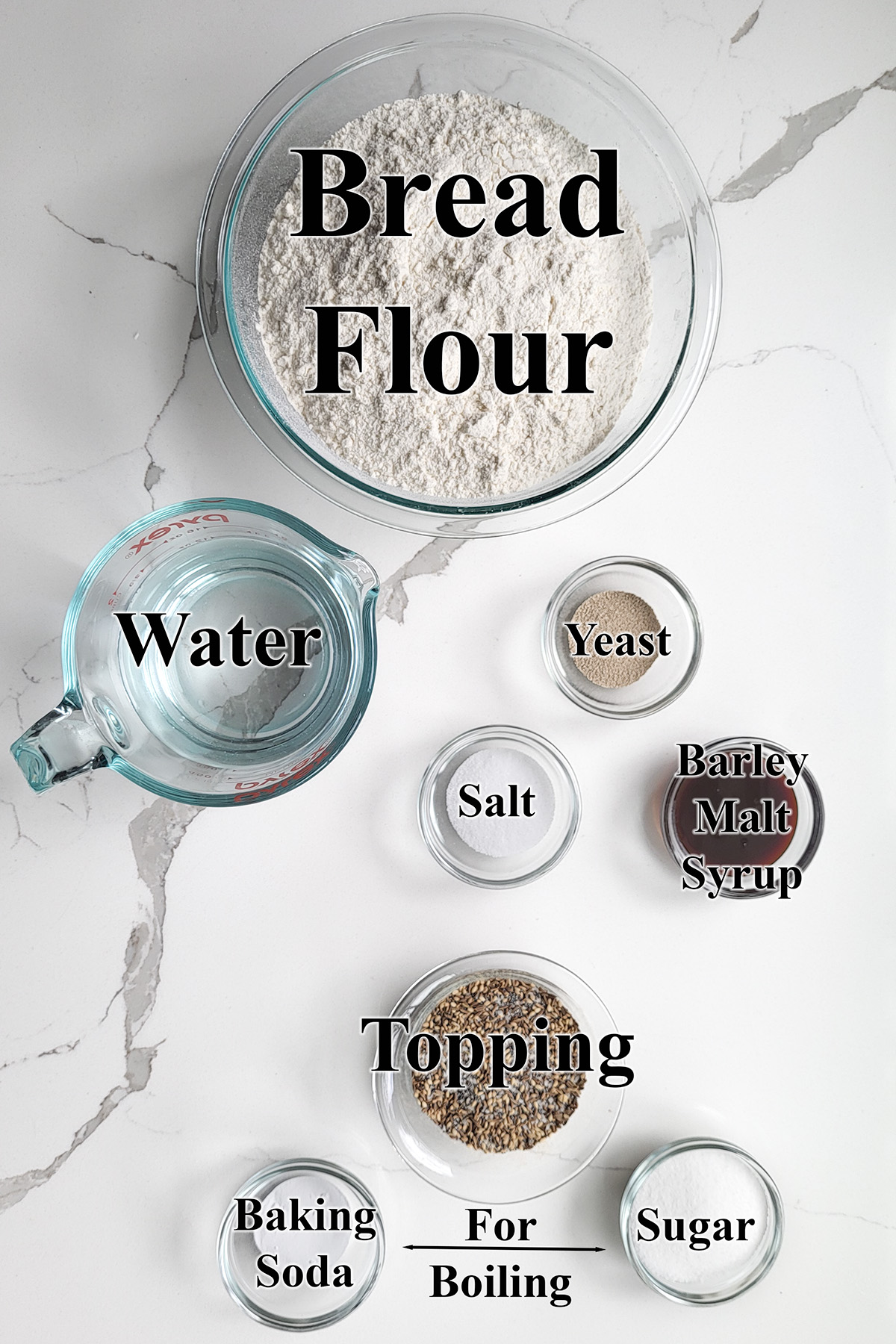
Ingredient Notes
- Bread Flour – Bagels should have a very chewy crumb from a strong gluten network in the dough. High protein bread flour develops plenty of gluten.
- Yeast – I prefer instant yeast to rapid rise yeast for a slightly slower rise. A slow overnight rise gives more time for flavor to develop.
- Barley Malt Syrup – Adds a traditional slightly sweet note to the dough. You can substitute honey or a combination or honey and molasses for the barley malt syrup.
- Toppings – Leave the bagels plain or use your favorite seed for topping. You can mix seeds with salt to make your own “everything” bagel topping”. See the recipe card for details.
- Baking Soda & Sugar – For boiling the bagels. The boiling process creates the specific shiny and chewy bagel crust.
How to make New York style Bagels
See the recipe card for detailed measurements and instructions.
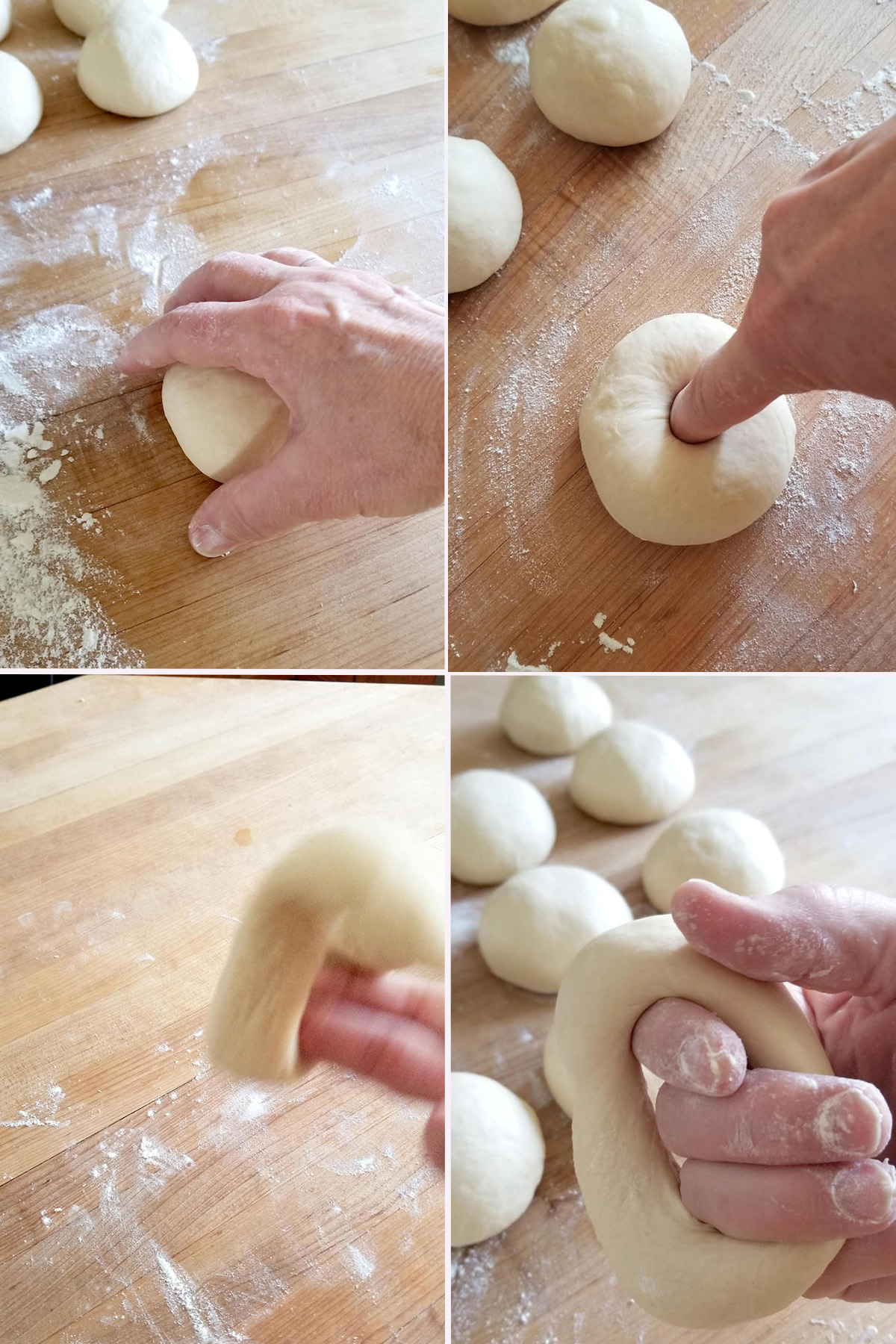
- Use a cupped hand to form the a piece of dough into a smooth ball.
- Poke your finger all the way through the center of the ball to make a hole.
- Twirl the dough around your fingers to widen the center hole.
- Set the bagel onto the baking sheet and continue with the rest of the dough.
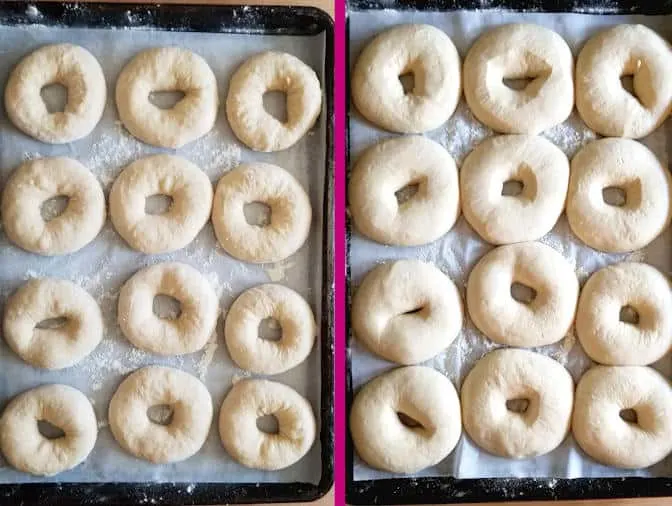
- Cover the pan and place the bagels in the refrigerator overnight.
- If you want to make the bagels the same day set them aside at room temperature for 1 hour.
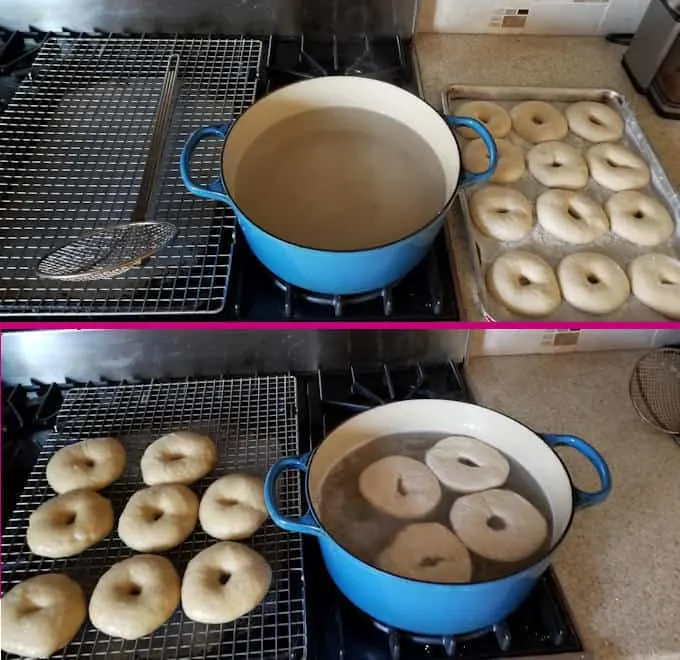
- Bring a pot of water with baking soda and sugar to a boil. Preheat the oven.
- Boil the bagels a few at a time, flipping them every thirty seconds. Boil each batch for 2 minutes.
- Transfer the bagels to a rack to drain while you finish boiling the rest of the bagels.
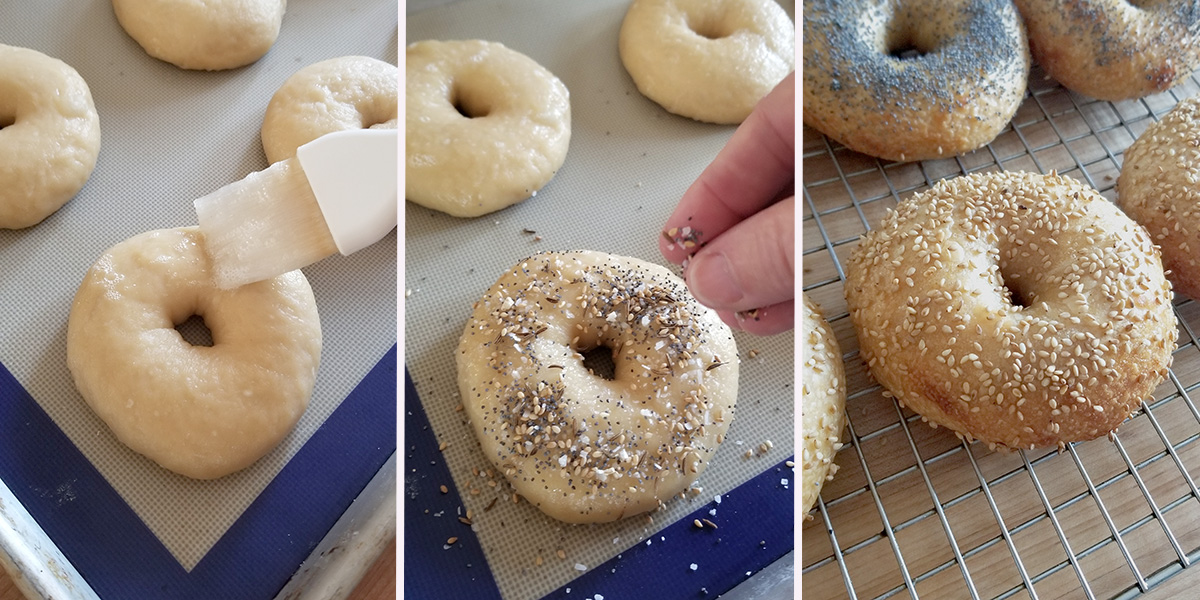
- Brush the boiled bagels with egg white.
- Sprinkle seeds or bagel topping if desired.
- Bake until the bagels are golden brown.
Recipe Tips
- Allow the sponge to rest for 30 minutes before mixing the dough. During that rest the water has time to hydrate the flour and gives us a head start on gluten develop.
- To make the bagels the same day, skip the overnight rise in the refrigerator.
- Bagels are best the day they are baked. For longer term storage slice the bagels about 3/4 the way through and pack them into freezer bags.
- Previously frozen bagels are best if toasted before serving.

You might also like to try these Cinnamon Raisin Bagels.
If you love this recipe as much as I do, I’d really appreciate a star rating and a quick comment. Ratings and comments help my recipes show in search results. Thanks!
Overnight Bagel Recipe
Ingredients
- 16 oz warm water (2 cups (about 100°F))
- ¼ oz instant yeast (2 ¼ teaspoons)
- 25 oz bread flour (5 cups, divided, see note)
- 1 ½ oz barley malt syrup ( 2 tablespoons, see note)
- 1 tablespoon table salt
- 2 oz granulated sugar (¼ cup (for boiling))
- 2 teaspoons baking soda (for boiling)
- 1 egg white (whisked lightly)
- Topping (Sesame seeds, poppy seeds, caraway seeds or coarse sea salt)
Instructions
- In a bowl for a stand mixer or a large mixing bowl combine 16 oz warm water, ¼ oz instant yeast and 3 cups (15 oz) of the flour . Mix to form a thick batter. Cover the bowl and set aside for 30-60 minutes.
- Add 1 ½ oz barley malt syrup and 1 tablespoon table salt. If using a stand mixer, switch to the dough hook. Add the remaining flour and mix to combine. Knead 5 minutes on medium/low speed. If working by hand, stir in as much of the flour as you can, then turn the dough out onto a lightly floured surface and knead in the remaining flour. Knead 5 minutes. Form the dough into a smooth ball.
- Put the dough into a lightly oiled bowl, turning once to coat the dough. Cover the bowl and set aside to rise until doubled in size, about 1 hour.
- Line a half sheet pan with parchment paper lightly sprinkled with flour or sprinkle the pan generously with cornmeal. Turn the dough out onto a lightly floured surface and knead briefly. Divide the dough into 10 even pieces. Use a cupped hand to roll each piece into a smooth, tight ball.
- To form a bagel, poke your finger all the way through the center of a ball to make a hole. Use two fingers to gently widen the hole. Continue gently stretching to form the bagel or twirl the dough around your fingers to widen the center hole (see photos). The hole should be 1 – 1 ½" wide.
- Place the bagel on the prepared sheet pan and continue to form the remaining bagels. The dough will probably spring back a bit so you can go back and re-stretch them once you're done forming all the bagels. Cover the pan with lighly oiled plastic wrap and leave at room temperature for 15 minutes then place the pan in the refrigerator overnight.
- In the morning, take the pan out of the refrigerator. The bagels should be noticeably fuller. Leave the tray out until the bagels come to room temperature, about 1 – 1 ½ hours. The time will vary based on the temperature in the room and how much the dough rose in the refrigerator. Once the dough comes to room temperature the bagels are ready to boil.
- Meanwhile, preheat the oven to 450 °F. In a large pot combine 1 gallon of water with 2 oz granulated sugar and 2 teaspoons baking soda and bring it to a boil. Reduce the heat to keep the water at a rolling simmer. Set a cooling rack over a clean sheet pan and place it next to the stove.
- Lift a bagel off the sheet pan and lower it into the boiling water, bottom side down. Depending on the size of your pot, you can boil 3-4 bagels at a time. Boil the bagels for 30 seconds then flip them. Boil the other side for 30 seconds. Repeat the process again for a total of 2 minutes boiling time. Remove the boiled bagels from the water and set them on the cooling rack to drain.
- Line two half-sheet pans with parchment paper or silicone baking mats and generously sprinkle with cornmeal (or flour). Place 5 of the boiled bagels on each sheet pan. You could fit them all on one pan but they may rise enough to stick together as they bake. I like all the sides to be crusty so I leave plenty of room between them.
- Brush the bagels with egg white. You can leave the bagels plain or add the topping of your choice. To make "everything" bagels combine a tablespoon of each of sesame seeds, poppy seeds & salt with a 1/8 teaspoon garlic powder and onion powder. Adjust toppings to your taste.
- Bake until golden brown, about 20 minutes.
Would you like to save this recipe?
As an Amazon Associate and member of other affiliate programs, I earn from qualifying purchases.









Sorry, not freeze, put in fridge.
Hi Eileen,
This seems like a great recipe but I have had the same issues as other people and I follow your instructions to a t (well the second time around).
1) First, please fix the weight translation in Step 1 (it says to add all 25 oz of flour which is not 3 cups), which led me astray the first time I made these. As a result I got no sponge. I still plowed ahead and the end result was pretty decent.
2) Also, for those of us who just go on automatic pilot, please remind us to put flower on the parchment paper and oil on the film, or the dough sticks miserably. It had risen fine but they deflated while “unsticking” them. I had to reshape my bagels but they did inflate when baking and still came out pretty nice.
3) The second time around no problems with the sticking to paper/film, but when I picked them up after the 1.5 h at room temperature, they could not hold their shape, deflated and fell apart. I baked half of them like that and reshaped then baked the other half. By then I was extremely frustrated. The reshaped ones look ok. And they taste great.
4) At this point I am with others and wonder why it is preferable to shape and freeze than the other way around or else what is the trick for them not to fall apart after warming up back to room temperature.
Thanks !
1. The weight listed in step one is the total amount of flour for the recipe. That automatically populates from the ingredient list. The instructions specify 3 cups. I did add a note next to the 3 cups that is 15oz.
2. I try to be as detailed with my instructions without overwhelming with too much text. I put extra reminders in those steps. For me, I prefer cornmeal to anything else for preventing the bagels from sticking.
3. I can’t say what happened. But if they deflated it’s likely they were over-risen. The amount of time needed at this stage will vary based on the temperature of the room and you do have to use your own judgement as to when the dough is ready. I added yet another note to this step but the more often you bake bread doughs you’ll get used to reading the dough.
4. I prefer to shape then refrigerate so all I have to do in the morning is boil and bake. Although I developed this recipe you are free to change the way you make the bagels to suit your own schedule.
Hi Eileen,
I have some questions regarding this recipe.
After step one I gave it 30 min time at 32° C in a combi oven (with some additional steam). It hat already risen significantially. I used Wheat flour type 550, which is the standard flour in Germany. I just realized I should have gotten type 812, which is more like bread flour.
I kneaded using a hand mixer for more about seven minutes, as it only ever kneads a spot and not the whole dough as a stand mixer does. Afterwards, the dough was still really sticky and it was hard to get it into the oiled bowl.
It is now once again proofing in the combi oven, same setting as before.
1. Anyway to still help the gluten develop? Do I need to add more flour?
2. I had planned to steam the bagels at 100° C instead of boiling them. I’ve found another recipe which says to steam them for 7 min; Steaming takes longer than boiling, but this seems like a rather large difference?
3. If I’d steam them, I can’t add sugar or baking soda – what are they needed for? Can I cover them with a concentraded solution of sugar and baking soda using a brush instead? If so, what ratio would you use for the solution?
Thank you very much!
As far as developing gluten, using a strong flour like bread flour is the best way to get great gluten development for this dough. If your mixer doesn’t mix well you could try kneading by hand. Use plenty of flour and a light touch to start. I have never hear of steaming bagels so I couldn’t comment on that. Is there a reason you prefer to steam rather than boil?
I have a couple of questions/comments about this recipe…I hope you will respond to me. Admittedly, I’m not an expert bread maker but I have baked quite a few types of bread and have advanced a little beyond beginner. Here are the issues I experienced…
1. After pulling from the fridge – I let them set for 1 1/2 hours. They were flat and some were very, very wrinkled. Looked like an old prune.
2. When I was ready to boil them they were very difficult to handle. So soft and some fell into a blob. I had to try and reshape them which did not go well.
3. Baking went ok…I did add 5 minutes on to the 20 minutes to get to a golden brown. No two look alike. Size wise was my problem, I should have weighed each one when forming. Otherwise, after the bake some are flat, some very tall, some very wrinkled.
4. Taste – tops were not crispy, bottoms were crispy. Insides was less chewy and more cake-like.
Clearly, I’ve done many things wrong and would really appreciate some help from experts. Disclaimer: I did use molasses in place of barely malt.
Thank you in advance.
Tom
The way you describe the dough being soft and like a “blob” it sounds like maybe you didn’t have good gluten development. Did you use unbleached bread flour? Did you weigh your ingredients? Did you knead for 5 minutes?
A person could also use a bread machine to mix the sponge, leave it for 30-60 minutes, and then add the rest of the ingredients and let the machine knead the dough. I don’t have a stand mixer and kneading is hard on my hands. I would do that but I would not have room in my fridge for the formed bagels even in half-sheet pans which I don’t have]. I wish you provided an option for leaving the dough in the fridge overnight, then shaping the bagels the next morning and leaving them for as long as needed to be ready to submerge in simmering water. Then I could try this recipe with its wonderful reviews.
Well, you could do exactly as you described. Refrigerate the dough overnight then proceed with the recipe in the morning. The rise time will be a little longer, but otherwise should work well.